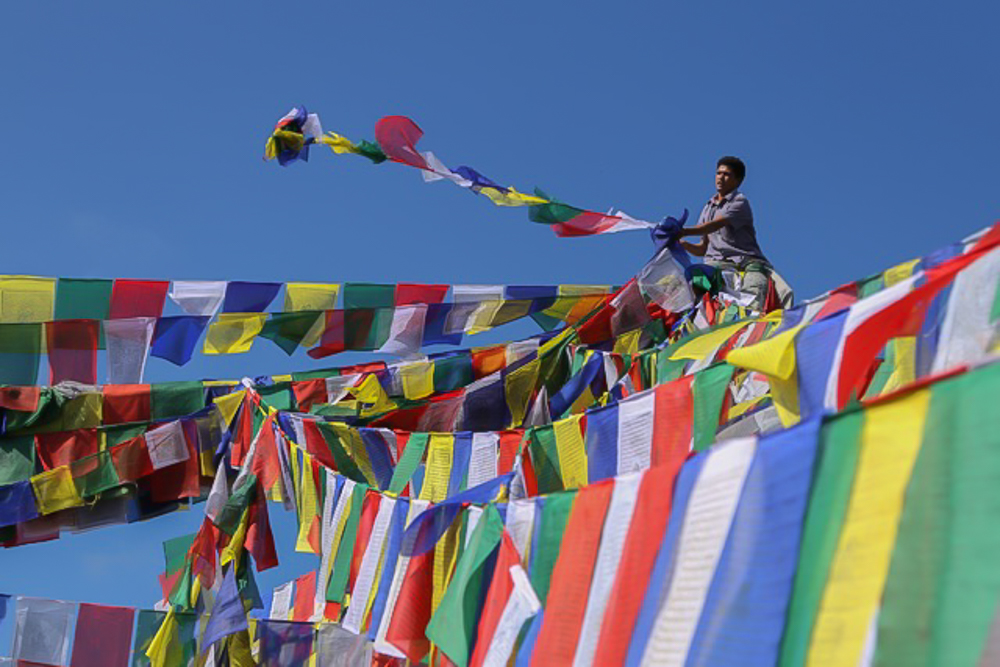Padmasambhava, also known as Guru Rinpoche (“Precious Guru”), has been revered for centuries in the Himalayan regions as the second Buddha. Based on research into ancient Buddhist manuscripts, the documentary film Precious Guru: Journey into the Wild Heart of the Second Buddha traces the spiritual life and legacy of this eighth-century tantric master—and relates some of the wild adventures he is said to have gone on. The film features the voices of contemporary teachers and practitioners, including Yongey Mingyur Rinpoche, Lama Tsultrim Allione, and Robert Thurman.
This film will be available to stream until 11:59 p.m. ET on Friday, December 2, 2022, and will be featured in an event at Tibet House in New York City on December 10. Tricycle subscribers can watch the film here.
The following is a brief interview with director Marc Wennberg, lightly edited for clarity.
What inspired you to make the film Precious Guru? I did not set out to make a film. I began this project because Guru Rinpoche’s story kept surfacing in my life and travels and I wanted to know more. What began as a personal exploration became an idea for a multimedia project that became a production trip and finally, a film. It was only time that helped clarify the central work of the documentary. Precious Guru is my expression of gratitude for this journey: for the surface, depths, and beauty of Guru Rinpoche’s story; and for the Himalayan storytellers who keep this story alive and present.
It seems you did a great deal of traveling in making this film. What was the greatest challenge you faced? We traveled more than 16,000 miles in eight weeks. We began our production trip in Mongolia and then traveled to Nepal, Tibet, Bhutan, and finally India. The constant travel was a physical, mental, and emotional challenge. Our production team—comprised of eight very talented and strong-minded individuals—struggled to find cohesiveness of vision. And then you add in the challenges that come at high altitudes! That said, in many ways, our eight-week whirlwind was incredible and successful. We met remarkable people to interview at the right times, we visited and filmed in stunningly beautiful places, our equipment worked flawlessly, and we returned home with all of our limbs! In hindsight, I like to say that ‘I wouldn’t change a thing about this first film experience, and if given the opportunity to do another project, I would change how I do everything.’
What was the reaction of ordinary Tibetans when you asked to speak to them about Padmasambhava? If nothing else, I hope our film captures the deep devotion that Tibetans have for their Precious Guru. Padmasambhava is omnipresent throughout the Himalaya, in both landscapes and people’s practices and prayers. The Himalayan people are the true keepers of this story and it is their devotion that has preserved and given life to this wise story. Recognizing this, it felt very important to center the Himalayan people as the storytellers of Precious Guru, and we attempted to do this throughout the film.
For whom was this film made and what is your hope that it will accomplish? First and foremost, may our film benefit many, many beings, and may it bring joy and wonder.
I also hope that our film adds to the growing awareness of the Guru Rinpoche story and the inherent wisdom that lies at the heart of this story. The tagline for our film is: the most extraordinary and least well-known story in the great religions reveals a radically relevant truth: the darker the times, the greater the opportunity for transformation. There is a lot to be discovered in Guru Rinpoche’s story that is particularly well-attuned to our times.
And finally, I hope the film serves as a lasting expression of gratitude for the Himalayan people who have nurtured, protected, and generously shared this remarkable and profound story with the world.
How did you choose the music for the film? Ah, the question that is most frequently asked at screenings! I came across Peter Rowan’s musical homage to Padmasambhava, “Across the Rolling Hills,” prior to our production trip. The song has energy and, in many ways, it captured the pace of our movement across the Himalayas. Once we settled on this foundational piece, which happened during editing, I mined Peter for additional music, including his collaboration with Tibetan vocalist Yungchen Lhamo, the group Mandolin Orange, and Cindy Cashdollar.
I also think the bluegrass music serves as a cultural bridge between an Eastern story and a mostly Western audience. As Peter has said, bluegrass is mountain music and it connects to that experience. And finally, the music is a little unexpected, which I also like!
Tricycle subscribers can watch Precious Guru here. Visit the film’s website here.
Thank you for subscribing to Tricycle! As a nonprofit, we depend on readers like you to keep Buddhist teachings and practices widely available.
